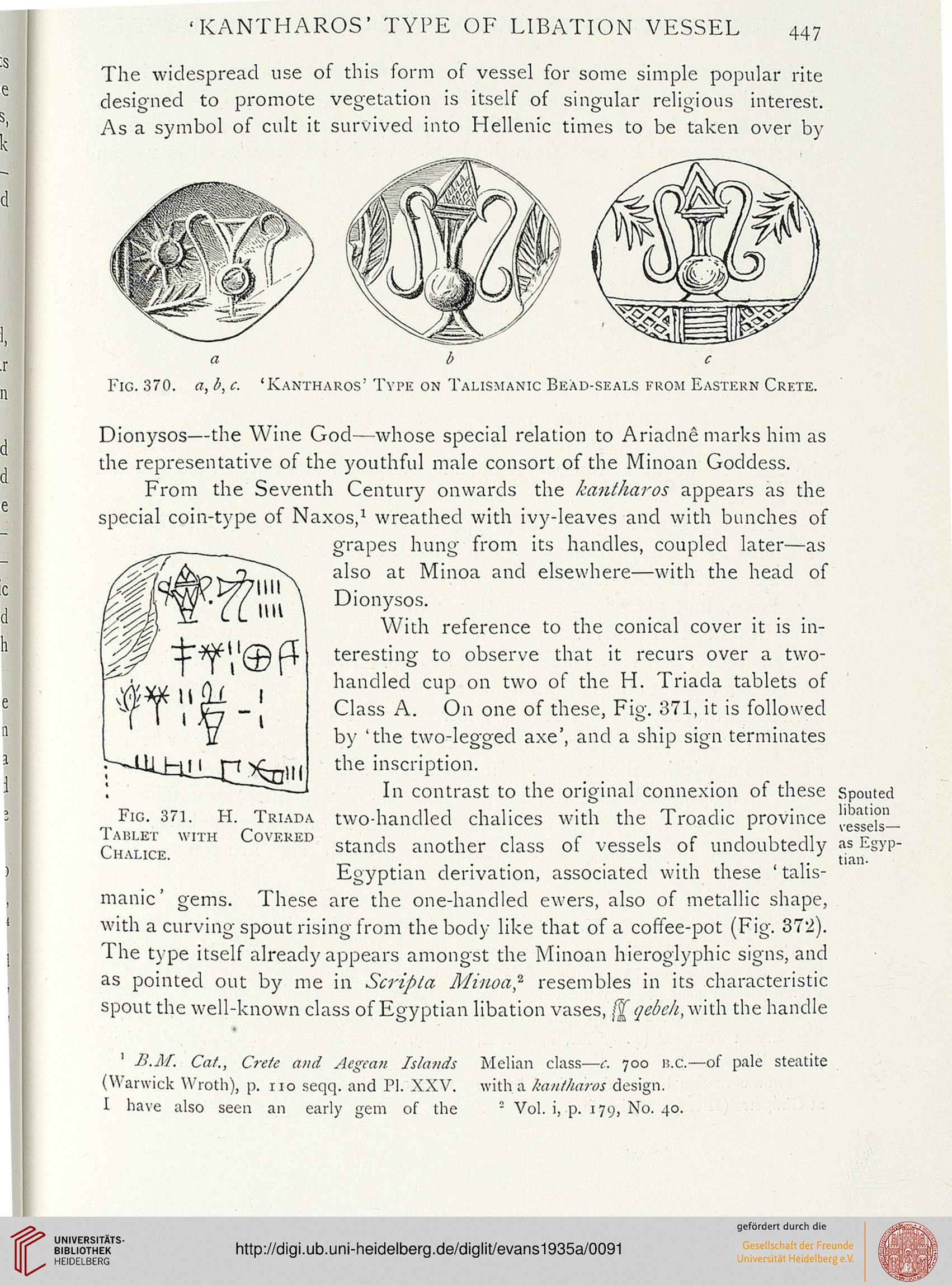'KANTHAROS' TYPE OF LIBATION VESSEL
447
The widespread use of this form of vessel for some simple popular rite
designed to promote vegetation is itself of singular religious interest.
As a symbol of cult it survived into Hellenic times to be taken over by
Fig. 370. a, b, c. 'Kantharos' Type on Talismanic Bead-seals from Eastern Crete.
Dionysos—the Wine God—whose special relation to Ariadne marks him as
the representative of the youthful male consort of the Minoan Goddess.
From the Seventh Century onwards the kantharos appears as the
special coin-type of Naxos,1 wreathed with ivy-leaves and with bunches of
grapes hung from its handles, coupled later—as
also at Minoa and elsewhere—with the head of
Dionysos.
With reference to the conical cover it is in-
teresting to observe that it recurs over a two-
handled cup on two of the H. Triada tablets of
Class A. On one of these, Fig. 371, it is followed
by 'the two-legged axe', and a ship sign terminates
the inscription.
In contrast to the original connexion of these
two-handled chalices with the Troadic province
stands another class of vessels of undoubtedly
Egyptian derivation, associated with these 'talis-
manic' gems. These are the one-handled ewers, also of metallic shape,
with a curving spout rising from the body like that of a coffee-pot (Fig. 372).
The type itself already appears amongst the Minoan hieroglyphic signs, and
as pointed out by me in Scripla Minoa* resembles in its characteristic
spout the well-known class of Egyptian libation vases, f% qebeh, with the handle
Fie. 371.
Tablet with
Chalice.
Spouted
libation
vessels—
as Egyp-
tian.
' B.M. Cat., Crete and Aegean Islands
(Warwick Wroth), p. no seqq. and PL XXV.
I have also seen an early gem of the
Melian class—c. 700 B.C.
with, a kantharos design.
' Vol. i, p. 179, No. 40.
-of pale steatite
447
The widespread use of this form of vessel for some simple popular rite
designed to promote vegetation is itself of singular religious interest.
As a symbol of cult it survived into Hellenic times to be taken over by
Fig. 370. a, b, c. 'Kantharos' Type on Talismanic Bead-seals from Eastern Crete.
Dionysos—the Wine God—whose special relation to Ariadne marks him as
the representative of the youthful male consort of the Minoan Goddess.
From the Seventh Century onwards the kantharos appears as the
special coin-type of Naxos,1 wreathed with ivy-leaves and with bunches of
grapes hung from its handles, coupled later—as
also at Minoa and elsewhere—with the head of
Dionysos.
With reference to the conical cover it is in-
teresting to observe that it recurs over a two-
handled cup on two of the H. Triada tablets of
Class A. On one of these, Fig. 371, it is followed
by 'the two-legged axe', and a ship sign terminates
the inscription.
In contrast to the original connexion of these
two-handled chalices with the Troadic province
stands another class of vessels of undoubtedly
Egyptian derivation, associated with these 'talis-
manic' gems. These are the one-handled ewers, also of metallic shape,
with a curving spout rising from the body like that of a coffee-pot (Fig. 372).
The type itself already appears amongst the Minoan hieroglyphic signs, and
as pointed out by me in Scripla Minoa* resembles in its characteristic
spout the well-known class of Egyptian libation vases, f% qebeh, with the handle
Fie. 371.
Tablet with
Chalice.
Spouted
libation
vessels—
as Egyp-
tian.
' B.M. Cat., Crete and Aegean Islands
(Warwick Wroth), p. no seqq. and PL XXV.
I have also seen an early gem of the
Melian class—c. 700 B.C.
with, a kantharos design.
' Vol. i, p. 179, No. 40.
-of pale steatite





